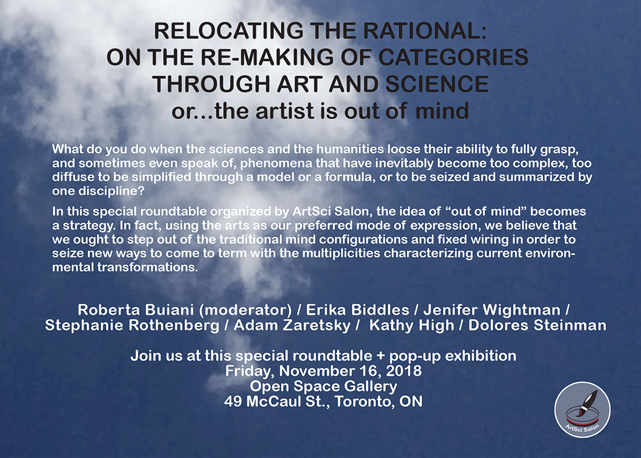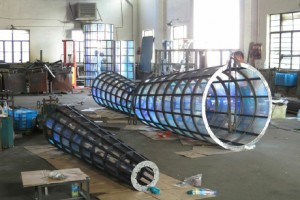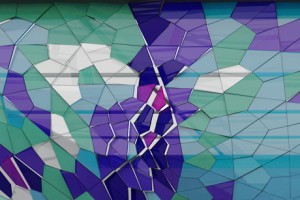I have two art/sci (or sciart) announcements, one concerns an event and the other is a news update.
Toronto’s ArtSci Salon and the Society of Literature, Science & the Arts (SLSA) 2018 Meeting
How could I not have stumbled across SLSA until now? Better late than never but the 2018 meeting/conference in Toronto, Canada is the 32nd of this annual event. (sigh)
Getting on to the important points, the ArtSci Salon is hosting a special roundtable as part of the conference (from a November 14, 2018 announcement received via email),
ArtSci Salon has organized a special roundtable at the annual SLSA
(Society for Science Literature and the Arts) which will take place in
Toronto this week.The roundtable is public and will be held at OCADU [Ontario College of Art and Design University] in the gallery on 49 McCaul Street.
Re-locating the rational: on the re-making of categories through art and science (or: the artist is out of mind!)
A roundtable and a mobile/pop-up exhibition organized by ArtSci Salon
The world always exceeds our conception of it (Shotwell, 2016)
Coinciding with this year’s SLSA “Out of Mind” conference in Toronto, ArtSci Salon is proposing a panel/roundtable on “out-of-mindedness” as a way to re-think categories, and to disrupt the disciplinary and methodological status quo through which we normally see science and the humanities unfolding in academic contexts. We plan to do it through a pop-up exhibition featuring the works of local artists and members of SLSA.
What to do when the sciences and the humanities loose [sic] their ability to fully grasp, and sometimes even speak of, phenomena that have inevitably become too complex, too diffuse to be simplified through a model or a formula, or to be seized and summarized by one discipline?
This initiative is not designed to propose a set of new categories, but to pose a series of open questions, highlighting the necessity to conduct collaborative research between artistic practices and scientific research. We interpret the idea of “out of mind” as a strategy. In fact, using the arts as our preferred mode of expression, we believe that we ought to step out of the traditional mind configurations and fixed wiring in order to seize new ways to come to term with the multiplicities characterizing current environmental transformations. These occurrences have proved to be connected with nature, culture, and society in too many intricate ways, to the extent that neither science, nor technological methods are able to fully comprehend them.
Roundtable Participants:
Roberta Buiani (Chair)
Erika Biddles
Jenifer Wightman
Stephanie Rothenberg
Adam Zaretsky
Kathy High
Dolores Steinman
Here’s the poster:

One more logistical detail,
[T]he roundtable will be at 10:30-12:00 noon [Friday, November 16, 2018] followed by a small tour of the mobile pop-up exhibition[.]
For the curious, here’s the SLSA website and the SLSA 2018 [Meeting]—Out of Your Mind website. Unexpectedly, the University of Toronto is not one of the conference hosts, instead we have the University of Waterloo [Waterloo, Ontario] and York University [Toronto, Ontario] as joint hosts with OCAD University—Canada’s oldest art and design institution—partnering with the Rochester Institute of Technology (New York state, US).
Vancouver’s Curiosity Collider
Coincidentally on the same day I received the ArtSci Salon event information, I received a November 14, 2018 update for Vancouver’s art/sci (or sciart) organization, Curiosity Collider. From the update received via email,
Collider Update
Next events (save-the-date), call for submissions, and other art+science in town
Collisions Festival:
Meet Up & Hang OutAre you an artist working in the sci/art genre? A scientist interested in collaborating with artists? Or one who wears both hats?
In the fall of 2019, the Curiosity Collider will be hosting our inaugural Sci-Art festival The Collisions Festival; the first theme will be Invasive Systems. The call for submission will be open in spring, 2019. The theme is meant to be broad in scope and not limited to any specific scientific subject/discipline; participants are encouraged to suggest various interpretation of the theme.
We would like to invite all artists and scientists who are interested in participating or potentially submitting a proposal to join us at this meet up event, chat about possible collaborations, and learn more about projects and details on “collaborative work” proposals we are looking for.
RSVP now so we know how many to expect.. This is a casual drop in event; feel free to stay, or just stop by and say hi!
Notice that RSVP? Taken with the next announcement, something becomes evident,
Join the Collider Team!
Are you passionate about art and science? Want to be part of the awesome Curiosity Collider team to help create new ways to experience science?
We are now inviting applications for the following positions:
- Development Director (volunteer board position, Deadline Dec 15)
- Digital/Social Media volunteers (until positions are filled)
Read more on our volunteer page. Feel free to contact us if you have any questions!
In the old days a ‘development director’ was a ‘fundraiser’. That RSVP? Likely, they’re trying to establish the size of their potential audience so they can get government grants. Audience size is important to corporate or ‘other’ funders but if you want a government grant you need numbers.
Getting back to the update, this is a grouping of Curiosity Collider’s latest hits,
#ColliderCafe: Art. Science. Cadence.
Did you miss our most recent Collider Cafe event? You can now chek out the talks by Singer-songwriter Devon More, Biologists Wayne Maddison and David Maddison, as well as Integrated Media Artist Victoria Gibson on our YouTube Channel.
Et al 3: Collaboration Process for Quantum Futures
Nerd Nite, Science Slam, and Curiosity Collider joined forces for the 3rd edition of Et al: the ultimate bar science night event. During the event, Quantum Physicist James Day and our Creative Managing Director Char Hoyt gave attendees an overview of the collaboration process that made Night shift: Quantum Futures, an event curated by CC and hosted at the Museum of Anthropology, possible.
Missed the show? Watch the presentation on our YouTube channel now.
While they don’t seem to have any details, there is a date for the next Collider Cafe,
Save the Date:
Next Collider CafeOur next Collider Cafe will be on Wednesday, January 23 at Cafe Deux Soleils. #ColliderCafe is a space for artists, scientists, makers, and anyone interested in art+science. Meet. Discover. Connect. Create.
Are you curious? Join us to explore how art and science intersect in the exploration of curiosity.
Finally, a miscellaneous listing of related events being held in Vancouver, mostly, this November,
Looking for more art+science in town?
- November 17 (Victoria) Science Writers and Communicators of Canada is hosting a workshop on science writing in an age of reconciliation: What science writers can learn from indigenous community members about better representation and relationships. Only a few spots left! Register now.
- November 15-18 CC friend Dzee Louise will open her studio during the East Side Cultural Crawl! Drop by at studio #5 just at the top of the stairs of the William Clark Building at 1310 William Street (on the corner of Clark).
- November 21 Natural History (Paleoart) Illustrator Julius Csotonyi will present a public lecture at the Vancouver Public Library (Kits branch) on the mutually beneficial affair between science and art.
- November 21 Our friends at Nerd Nite Vancouver is hosting another awesome event next week, including a presentation by artist Michael Markowsky who will talk about how he ends up “Painting on the Moon”. Get your tickets now!
- Until December 15 Vancouver Biennale’s CURIOUS IMAGININGS continues…check out the exhibition that will “challenge us to explore the social impacts of emerging biotechnology and our ethical limits in an age where genetic engineering and digital technologies are already pushing the boundaries of humanity.”
For more Vancouver art+science events, visit the Curiosity Collider events calendar. Let us know about your art+science events by emailing info@curiositycollider.org.
I did write a preview (June 18, 2018) for the last event on the list, Curious Imaginings, which included some of the latest science on xenotransplantation and chimeras (i.e., examples of emerging biotechnology). That’s all folks!

